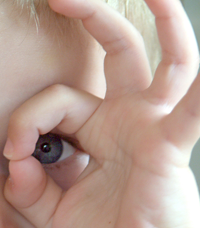The Eyes Have It!
Get the kids together, build a simple vision protractor, and play a fun game of "now you see it, now you don't" while exploring the world of peripheral vision.

Have you ever joked with your kids that you have eyes in the back of your head—letting you see things even when you seem to not be looking? While you probably only have eyes in the front, your eyes do use two different kinds of vision processes. So even when you are paying attention to something in front of you, you can see things that appear to the sides of what you are focusing on. How far to each side can you see? Is the range of peripheral vision the same for everyone?
You and your family can explore by making a cool vision protractor from foam board. Forget about the chart with the big "E" as you measure what "else" you can see, even when you aren't trying to!
(Image: Bigstock)It's a Side Issue
You are reading an exciting mystery in your favorite chair and suddenly spy one of your kids sneaking into the room to scare you. You and your kids are throwing baseball in the backyard, and as you catch the ball, you notice a friend waving at you over the fence. What do these two activities have in common? Peripheral vision!
One Set of Eyes, Two Kinds of Vision
We are almost always using both central vision and peripheral vision. Central vision is what we use to focus our eyes on one particular thing, such as a few words in a sentence or a particular tree in the yard. At the same time, our peripheral vision fills in the surrounding information. For example, if you focus your eyes on a tree in the yard, your peripheral vision fills in the grass, fence, bushes, and sky that are around the tree. What you see with peripheral vision is less sharply focused.
Our peripheral vision is controlled by the rods and cones in our retinas. Cones are sensitive to color, whereas rods are sensitive to motion. Rod cells are also better at sensing objects in dim light than cone cells are and are responsible for detecting things moving toward you before you can focus on them. The placement of the rods and cones on our retinas controls our peripheral vision.
Test Your Peripheral Vision
Just as people have different running abilities, people also have differing peripheral vision abilities. Using foam board, string, and a few other simple materials, you and your kids can build a vision protractor to compare each other's peripheral vision. The "Now You See It, Now You Don't" project guides you through the process. Once complete, the vision protractor is a fun tool for exploring what we really can and can't see. Test each other by moving small objects in and out of your range of vision. But don't cheat! Always keep your eyes focused on a fixed object directly in front of you.
Other questions you might explore using the vision protractor include: Is it easier to see some colors than others? Are larger objects easier to see than smaller ones? What role does ambient lighting play in peripheral vision? What if the objects are moving? What if you didn't have peripheral vision? How would your life be different?
Build the protractor, test your vision, and see how fun family summer science can be!
Science Buddies Project Ideas in Human Biology & Health are sponsored by the Medtronic Foundation.
Elmer's Products is the official classroom sponsor for Science Buddies.
Categories:
You Might Also Enjoy These Related Posts:
- 15 STEM Gifts & Science Kits You'll Feel Good About Giving
- 13 Boat Science and Submarine Science Projects and Experiments
- July 4th STEM! Summer Science Picks for Independence Day!
- 12 Science Kits for Summer Science Experiments and Discovery
- 15 Science Projects to Make and Give for Father's Day
- Ready, Set, Go! (Awesome Summer Science Experiments)
- Awesome Summer Science Experiments
- 10 STEM Activities with Cardboard Tubes









